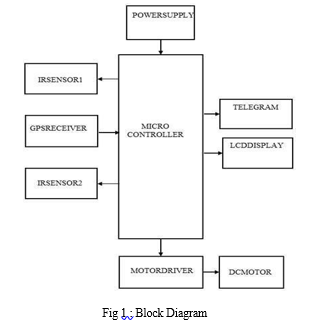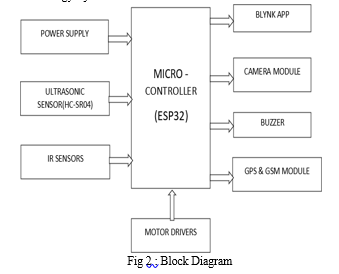Ijraset Journal For Research in Applied Science and Engineering Technology
- Home / Ijraset
- On This Page
- Abstract
- Introduction
- Conclusion
- References
- Copyright
Advanced Automation Detection of Cracks in Railway Tracks
Authors: Mr. B. Venkataramanaiaha, B. Niveditha, V. Tharun, E. Manith Reddy
DOI Link: https://doi.org/10.22214/ijraset.2024.63437
Certificate: View Certificate
Abstract
India’s transportation infrastructure relies heavily identification. The integration of IR sensors enables the early detection of cracks on the track surface, allowing for the timely identification of potential structural weaknesses, on the Indian Railways, which serves as a major means of long-distance travel for millions. Nevertheless, the discovery of cracks on railway tracks still poses serious problems that can compromise safety if not addressed. This paper therefore describes a path-breaking effort towards a strong crack detection mechanism in railways. Our unique way involves integrating infrared (IR) sensors for crack detection and ultrasound sensors for object detection to entirely change track monitoring thereby enhancing railway safety and maintenance efficiency. The system presented is able to detect any possible hazards within targeted area thus leading to prevention-based action through proactive maintenance; it also reduces cases of accidents as early detections helps in minimizing their chances of occurrence by making use of real-time data from these sensors. Our method demonstrates its effectiveness through experiments, showing that it can detect both cracks and blocking objects on the train tracks, hence contributing towards better rail safety systems while offering a promising direction for pre- emptive maintenance programs and risk control strategies. Our study proposes an innovative remedy for the current issue of security inclusion along railway tracks. With this combination involving IRs as well as ultrasonic sensors, our device has fulltime surveillance applications so that they are able to intervene timely before accidents are caused by this malfunctioning parts of the locomotive engines.
Introduction
I. INTRODUCTION
Continuous monitoring of railway tracks is essential to ensure their safe and efficient operation as critical infrastructure. Detecting cracks and identifying objects along these tracks is crucial for maintaining operational integrity and passenger safety. However, traditional manual inspection methods are labor- intensive, time-consuming, and prone to human error. To overcome these challenges, this paper proposes an innovative approach that utilizes IR sensors for crack detection and ultrasonic sensors for object Simultaneously, ultrasonic sensors are deployed to detect objects obstructing the railway, such as debris or fallen branches. This dual-sensor system provides a comprehensive solution for real-time monitoring of railway tracks, ultimately enhancing safety and operational efficiency.
Utilizing a combination of IR and ultrasonic sensors, our system provides ongoing monitoring of track conditions, facilitating proactive maintenance actions. Early identification of cracks and obstacles mitigates the potential for derailments, collisions, and other safety hazards, thus enhancing the dependability of railway operations. Additionally, this approach presents a cost- efficient alternative to conventional manual inspection techniques, resulting in decreased maintenance costs and minimized downtime caused by track closures. Through experimental validation, our system's capability and reliability in detecting cracks and objects on railway tracks are demonstrated.
This research presents a promising solution to enhance railway safety and maintenance practices through the integration of IR and ultrasonic sensors for crack detection and object identification. The proposed system contributes to the advancement of railway infrastructure management, offering a proactive approach to mitigate risks and ensure the uninterrupted flow of rail traffic.
II. LITERATURE REVIEW
In this paper “William Edberg, Emad Aboelela, Christos Papakonstantinou and Vinod Vokkarane, “Wireless Sensor Network Based Model for secure Railway Operations” IEEE Transactions on intelligent Transportation systems 2006” [1] The proposed aggregation technique in this systemis based on fuzzy logic to maximize information gain and minimize the false alarms. Reading measured by sensors and transmitted using the wireless network ingrain imprecision or fuzziness. WSNs are usually implemented in critical areas and sensor nodes are non-rechargable. Therefore, they present limitations in terms of power supplies, which brings about numerous challenges related to the optimization of the energy consumption.
In this paper “Xavier Gibert, Vishal M. Patel, Rama chellappa, “Deep Multitask Learning for Railway Track Inspection” IEEE Transactions on intelligent Transportation systems 2016” [2] In this paper, we show that detection performance can be improved by combining multiple detectors within a multitask learning framework. We show that this approach results in improved accuracy for detecting defects on railway ties and fasteners. It mainly works on the multitasking process, multitasking involves a multiple tasks running at a time periodically. This has been possible by setting up multiple tasks and cooperatively training a shared representation that is effective and complex.
In this paper “Ying Li, Hong Trinh, Norman Haas, Charles Otto and Sharath Pankanti, “Rail Component Detection, optimization, & Assessment for Automatic Rail Track Inspection” IEEE Transactions on intelligent Transportation systems 2019” [3] In this it uses the real time real-time automatic vision based rail inspection system . To achieve this goal we first develop a set of images and video analytics and then propose a novel global optimization framework to combine evidence from multiple cameras,GPS & distance measurement instrument to further improvethe detection performance. If it detects the crack or any faultsit sends the notification to the maintenance room for further actions. It detects the crack which we given in an set of images, this system is not capable of detect the other cracks which are not given the image processing.
In this paper “Fupei Wu, Xiaoyang Xie, Jiahua Guoand Qinghua Li, “Internal Defects Detection Method of the Railway Track Based on Generalization Features Cluster Under Ultrasonic Images” IEEE 2021” [4] In this study the defects are classified and counted according to their shape and location features by using the cluster method and then itis generalized. The generalized features of the internal defects are extracted and formulated based on the maximum difference between different types of defects and the maximum tolerance among same defects types.
In this paper “Sandra Dudley, Hafeez Ur Rehman Siddiqui and Muhammad Amjad Raza, “IOT Based Railway Track Faults Detection & Localization Using Acoustic Analysis” IEEE 2022” [5] In this it uses The crack is detected by using (IOT) based on their frequency occurrences of cracks .6 types of track faults were first targeted: wheel burnt, loose nuts, bolts & crash sleeper etc..,. In this it is difficult to detect the new type of crack that which are not given in the targets. But it transfers the capture data to the authority station with the accuracy of 98.4%.
III. EXISITING METHODOLOGY
Figure 1 depicts the block diagram of the "Railway track crack detection using IR sensor" system. It consists of two sets of IR sensor units mounted on the front side of the vehicle, along with a microcontroller, to inspect the railway track for cracks. Upon activation of the vehicle, it progresses forward along the track while the IR sensors assess the track's condition. Under normal circumstances, the system operates the motor, LDR, and Serial

Transmission is in initial stage. Upon receiving power, the microcontroller initiates motor movement in the forward direction and communicates via serial transmission. If acrack is detected by the IR sensor, the vehicle halts automatically. The GPS receiver determines the vehicle's position by triangulating signals from satellites to obtain Latitude and Longitude coordinates. These coordinates are then converted into a text message format by the microcontroller. Subsequently, the Wi-Fi Module facilitates the transmission of this text message through IoT technology, specifically utilizing the Telegram app.
IV. PROPOSED METHODOLOGY
The proposed methodology integrates Ultrasonic sensors, a GSM module, and the Blynk app to enhance railway track monitoring and safety. IR sensors will be strategically installed along the track to detect temperature differentials indicative of cracks, triggering alerts for inspection upon detection. Additionally, Ultrasonic sensors will be mounted on the locomotive to provide real-time detection of obstacles or irregularities. These sensors emit sound waves and analyze echoes to identify objects near the train, with object detection algorithms processing the data to identify potential obstacles. The system will employ trained object detection models to recognize specific patterns corresponding to obstacles or anomalies, alerting the operator or activating automated braking systems upon detection. Continuous monitoring of both IR and Ultrasonic sensors will ensure timely responses to track defects and obstacles, supported by periodic maintenance and calibration to uphold detection accuracy. System performance will be evaluated through rigorous testing, with methodology adjustments based on real-world feedback aimed at enhancing safety and reliability.

A. At Normal Condition
The IR transmitter sensor is transmitting the infrared rays and received by the IR receiver. At normal condition Transistor is OFF condition, at the same time relay is also OFF, so that the vehicle moving forward continuously.
B. At Crack Condition
At crack detection conditions the IR transmitter transmit infrared rays and received by the IR receiver after hitting the object. If there is no crack present on the track then output of IR LED and Photodiode will be high.
V. COMPONENTS
A. ESP32 Microcontroller
The ESP32, developed by Espressif Systems, stands out as a highly versatile microcontroller renowned for its extensive array of features and functionalities. Part of the ESP32's appeal lies in its affordability and energy efficiency, making it an ideal choice for a wide range of applications. Equipped with integrated Wi-Fi and dual- mode Bluetooth capabilities, the ESP32 offers seamless connectivity options. With a total of 38 pins,encompassing GPIO, power, ground, and specialized pins, this microcontroller provides ample flexibility tomeet diverse project needs.
Operating at a default clock frequency of 80 MHz, which can be overclocked to 160 MHz, the ESP32 strikes a balance between performance and power consumption. Furthermore, it operates withina voltage range of 2.2V to 3.6V, ensuring compatibility with various power sources and devices.


E. Blynk APP
The Blynk app serves as a versatile platform tailored for IoT applications, providing users with an intuitive interface for designing custom dashboards to oversee and manage connected devices. Its user-friendly features include drag-and-drop functionality, enabling effortless integration of buttons, sliders, graphs, and various widgets to tailor interfaces to individual preferences. Compatible with a wide array of hardware platforms such as ESP32 and ESP32-CAM, Blynk facilitates real-time communication between the hardware and the app through the Blynk Cloud service. This seamless connectivity empowers users to remotely administer devices, monitor sensor data, receive timely notifications, and securely storedata in the cloud.
VI. WORKING
IR sensors are strategically positioned along railway tracks to detect any surface irregularities or cracks. These sensors emit infrared beams directed perpendicular or atspecific angles to the track surface. When these beams encounter a crack or irregularity, they reflect or absorb differently than on normal track surfaces. The IR sensors detect these variations in absorption or reflection. Signals received by the sensors undergo processing by a microcontroller (e.g., ESP-32) or a dedicated signal processing unit. This processing involves analyzing the intensity and pattern of the reflected or absorbed IR beams to determine the presence of cracks or irregularities.
Algorithms differentiate between normal track conditions and the presence of cracks. Upon detection, the system generates an alert signal, which can trigger various actions such as notifying railway authorities through applications like Blynk, activating warning signals (e.g., buzzers, red lights) at authority stations, or halting train operations in affected sections until maintenance is performed. Additionally, the system may include features for logging crack detection events, aiding in maintenance planning and inspection scheduling to ensure railway track safety and integrity.
After computing the distance, it is compared with a predetermined threshold distance, established based on safety regulations and the necessary warning range for the railway track. If the calculated distance falls below this threshold, indicating that an object like a train is nearing the sensor beyond a safe proximity, the system initiates an alert. This alert can activate several responses, including illuminating warning lights, sounding alarms, or notifying train operators or railway authorities. Continuously, the system observes the distance between the sensor and potential obstacles along the track, issuing real-time alerts to uphold train operation safety.
An ultrasonic sensor is installed at a specific location along the railway track, typically mounted above the track facing downwards. This sensor emits ultrasonic waves in a particular direction. The ultrasonic sensor emits a burst of ultrasonic waves towards the track surface.
These ultrasonic waves propagate until they encounter an obstacle, such as a train or any other object on the track. When the ultrasonic waves hit the obstacle, they are reflected back towards the sensor. The sensor measures the time taken for the ultrasonic waves to travel from the sensor to the obstacle and back. This time measurement is directly proportional to the distance between the sensor and the obstacle. Using the known speed of sound in the air, the system calculates the distance to the obstacle based on the time measured for the ultrasonic waves to travel.
VII. RESULTS & ANALYSIS
The following figure is the proposed Advanced Automation Detection of cracks in railway tracks. The whole depends on the ESP-32 Microcontroller, IR sensor, Ultra-sonic sensor, camera module, GPS, GSM modules.

Conclusion
The fusion of advanced automation with IR sensors for track detection and ultrasonic sensors for object detection marks a significant leap in railway safety and efficiency. This integration enables precise identification of tracks and obstacles, allowing for swift responses to potential hazards. IR sensors ensure reliable track detection, while ultrasonic sensors enhance object detection, facilitating proactive collision avoidance. This combined approach enhances safety for passengers and cargo, streamlining operations and paving the way for modernizing railway infrastructure.
References
[1] Y Xia, YG Wei, YH Lai, et al. “Research on the line plan of passenger-like transport system of railway container based on transportation organization mode”. Chinese Journalof Mechanical Engineering -July 2017. [2] Q Y Peng, Y X Zhang, G Y Lu, et al. “Arrival and departure tracks utilization adjustment method in railway passenger stations based on time-space resources”. Journal of Tongji University (Natural Science), June 2019. [3] H M Shi, Z J Yu, L Q Zhu, et al. “Study on the monitoring method of longitudinal displacement for the high-speed continuous welded rail”. Chinese Journal of Scientific Instrument- 2016. [4] M. Singh, S. Singh, J. Jaiswal, and J. Hemp shall, \"Autonomous rail track inspectionusing vision-based system, “IEEE -2006. [5] Xavier Gibert, Vishal M. Patel, “Deep Multitask Learning for Railway Track Inspection” International Research Journal of Engineering & Technology, IRJET- 2019 Sandra Dudley, “IoT Based Railway Track Faults Detection and Localization Using Acoustic Analysis”, IEEE-2019. [6] A. Karnik, D. Adke and P. Sathe, \" A data fusion approach for track monitoring from multiple in-service trains\", 2020 IEEE Bombay Section Signature Conference (IBSSC), pp. 113-118, 2020. [7] G Lulla,” “Visual recognition system of elastic rail clips for mass rapid transit systems in IEEE access, 2021 Institute of Electrical and Electronics Engineers ,2021 Int. Conf. on Emerging Smart Computing and Informatics (ESCI) AISSMS Institute of Information Technology 2021. [8] Q Y Peng, Y X Zhang, G Y Lu, et al. Arrival and departure tracks utilization adjustment method in railway passenger stations based on time-space resources. Journal of Tongji University(Natural Science), 2019. [9] Z. Liu, A. D. Koffman, B. C. Waltrip, and Y. Wang, “Eddy current rail inspection using Abridge techniques,” - 2013.
Copyright
Copyright © 2024 Mr. B. Venkataramanaiaha, B. Niveditha, V. Tharun, E. Manith Reddy. This is an open access article distributed under the Creative Commons Attribution License, which permits unrestricted use, distribution, and reproduction in any medium, provided the original work is properly cited.

Download Paper
Paper Id : IJRASET63437
Publish Date : 2024-06-24
ISSN : 2321-9653
Publisher Name : IJRASET
DOI Link : Click Here
 Submit Paper Online
Submit Paper Online

